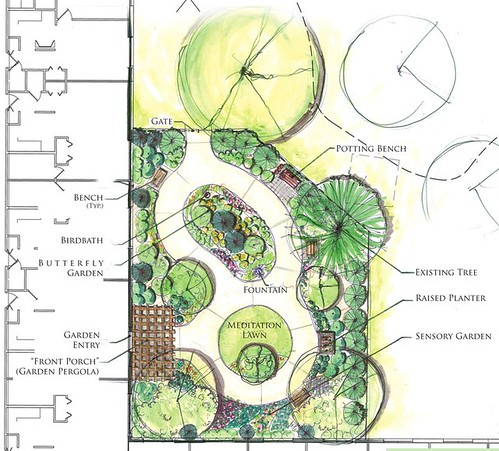A garden for the elderly fosters a personal brand of sustainability

Posted October 11, 2010 at 1:29PM
Often sustainability must be writ small. In fact, it is in our most intimate outdoor spaces that we sometimes make the most personal connections to nature and the wonders of the natural world.
Couple that thought with the plight of elders in the US, particularly those suffering from Alzheimer’s or other dementia. Unfortunately, such is the case with my own family, so this is an issue dear to my heart. Can creating a connection to nature help? Can we do so safely and with sensitivity to the frailties of this population?
Chartwell Seniors Housing, based in Richmond, Virginia, thinks so. For Gayton Terrace, a 100-unit retirement and assisted living home, Chartwell has created a “memory garden” in order “to provide a space that [is] functional, enjoyable, and safe for Alzheimer's and Dementia patients to use on a daily basis.”
The garden was designed by Richmond’s DesignForum, a design and planning firm with its roots in landscape architecture. From the firm’s website:
“The design concept for the memory garden was based on the importance of providing elements that foster memories. Many of the experiences we have growing up remain with us the rest of our lives, such as watching butterflies flutter in the garden, the fragrance of lilac flowers, or relaxing on the front porch. The design for the memory garden highlights this idea by incorporating familiar elements that are indented to rekindle past memories. For instance, hydrangea, lilac, and flowering annual plants are used throughout the garden. Garden benches, a front porch (garden pergola), and butterfly garden aid in the user’s recollections of past memories.
“Other elements within the garden include, a sensory garden, potting bench, and flowering planters. The plants and materials used in the garden are non-toxic and safe to touch. This allows the user’s to interact with different plants/materials and provide them the opportunity to get their hands dirty.
“The navigation experience through the garden was designed to be user friendly and safe. The ‘figure eight’ garden path eliminates dead ends and minimizes confusion. A garden fence aids the need to keeps patients in the garden, in view of the staff, without the user feeling confined.”
This kind of sensitive design is so important. The Gayton Terrace memory garden may not have the overriding environmental impact of a regional planning law or major transit system. It’s not the sort of thing that an organization like NRDC is likely to become involved in. But sustainability occurs at all scales. And so does thoughtfulness. Good for Chartwell and DesignForum for stepping up with good design that can make a difference in people’s lives, and perhaps help establish a model for others.
Move your cursor over the images for credit information.


